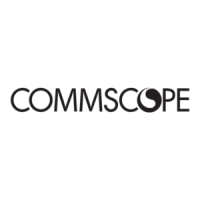
Do you have a question about the CommScope ICX7400-4X10GF and is the answer not in the manual?
| Model | ICX7400-4X10GF |
|---|---|
| Category | Switch |
| Layer | Layer 3 |
| Ports | 4 x 10 Gigabit Ethernet |
| Operating Temperature | 32°F to 113°F (0°C to 45°C) |
| Humidity | 5% to 95% non-condensing |
| Interface Type | Ethernet |
Defines text conventions like bold, italics, and monospace for clarity.
Explains the use of NOTE, CAUTION, and DANGER statements for hazard communication.
Explains conventions for command syntax elements like bold, italics, and brackets.
Summarizes new information or enhancements added to the current edition.
Details the key capabilities and specifications of the Ruckus ICX 7450 switch.
Lists the SKUs and options for building custom Ruckus ICX 7450 configurations.
Provides visual guides and labels for the front and rear views of the switch models.
Explains the numbering scheme for slots and Ethernet ports used in CLI commands.
Lists and describes the available expansion modules for Ruckus ICX 7450 switches.
Refers to external documentation for supported optical transceivers and cables.
Lists all items included in the shipping carton for the Ruckus ICX 7450 device.
Outlines general requirements and safety guidelines for installing the Ruckus ICX 7450.
Provides specific warnings and precautions to follow during the installation process.
Details the steps for installing the Ruckus ICX 7450 on a flat surface or desktop.
Explains the procedures and considerations for mounting the Ruckus ICX 7450 into an equipment rack.
Provides instructions for mounting the Ruckus ICX 7450 in a two-post rack system.
Guides the installation using a specific kit for four-post racks.
Details the process for mounting the device flush with the front of a rack.
Details the process for mounting the device recessed from the front of a rack.
Explains how to connect multiple Ruckus ICX 7450 units to form a stack.
Identifies the ports used for stacking devices in a Ruckus ICX 7450 system.
Outlines the prerequisites for configuring devices in a stack.
Specifies the types of cables required for connecting devices in a stack.
Defines the maximum number of devices that can be included in a stack.
Describes supported linear and ring topologies for device stacking.
Provides instructions for properly grounding the Ruckus ICX 7450 system.
Details the steps required to power on the Ruckus ICX 7450 switch.
Explains how to interpret the status and activity indicated by the LEDs on the switch.
Describes the LEDs located on the front panel of the Ruckus ICX 7450 switch.
Describes the LEDs located on the rear panel of the Ruckus ICX 7450 switch.
Provides tables detailing the different states and meanings of the switch's LEDs.
Explains how to use system diagnostic tests to troubleshoot hardware issues.
Covers monitoring temperature, fan speeds, and power supply status for optimal operation.
Lists general system components like enclosure, power supplies, fans, and architecture.
Details Ethernet port types, speeds, and supported expansion modules for various models.
Summarizes the types of LEDs present on the switch for status indication.
Lists other system components such as serial cables and power cords.
Provides physical dimensions and weight specifications for different Ruckus ICX 7450 models.
Specifies operational and non-operational environmental conditions like temperature and humidity.
Details input voltage, current, and protection for each power supply unit.
Lists power consumption figures for typical operating scenarios.
Lists power consumption figures for maximum load scenarios.
Details power consumption for various expansion modules and fans.
Specifies port types, numbers, and compatibility for Ethernet data ports.
Provides pinout details for the mini-USB serial console port.
Defines the serial port communication parameters like baud rate and data bits.
Lists memory types and sizes for the switch, including main memory and flash storage.
Lists electromagnetic compatibility certifications and standards met by the device.
Lists safety certifications and standards applicable to the Ruckus ICX 7450.
Lists environmental compliance standards and directives for the device.
States compliance with FCC rules for Class A digital devices in commercial environments.
Declares compliance with Canadian NMB-003 standard for Class A digital apparatus.
Warns about potential radio interference in domestic environments for Class A products.
Provides noise level information according to German regulations and EN ISO 7779.
States compliance with VCCI standards for Class A products and potential radio disturbance.
Confirms EMC registration for office use (Class A) and suitability for places other than home.
States Class A compliance and warnings regarding radio interference in domestic environments.
Warns about Class A product potential radio interference in domestic environments.
Provides warnings about potential hazards that can damage equipment.
Alerts users to potential hazards that could cause personal injury or death.